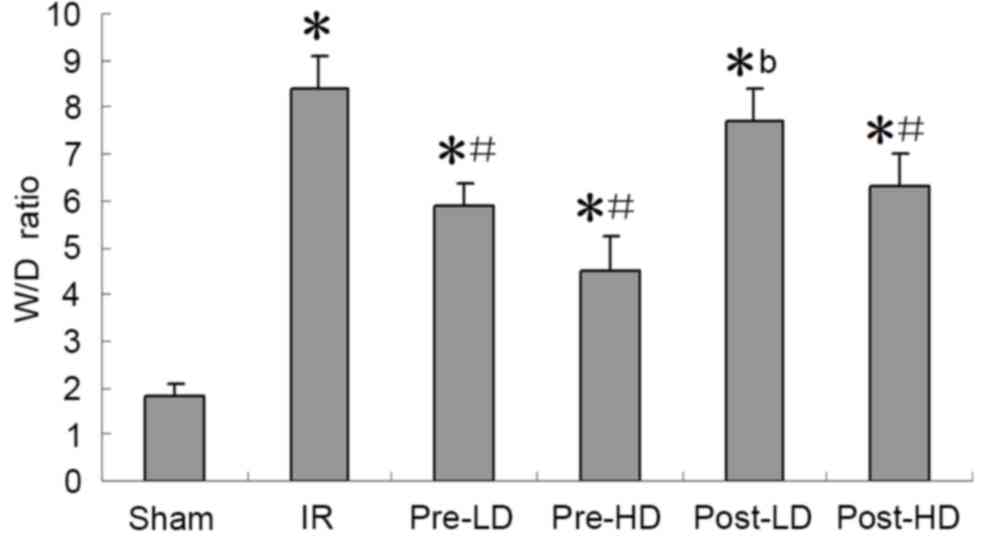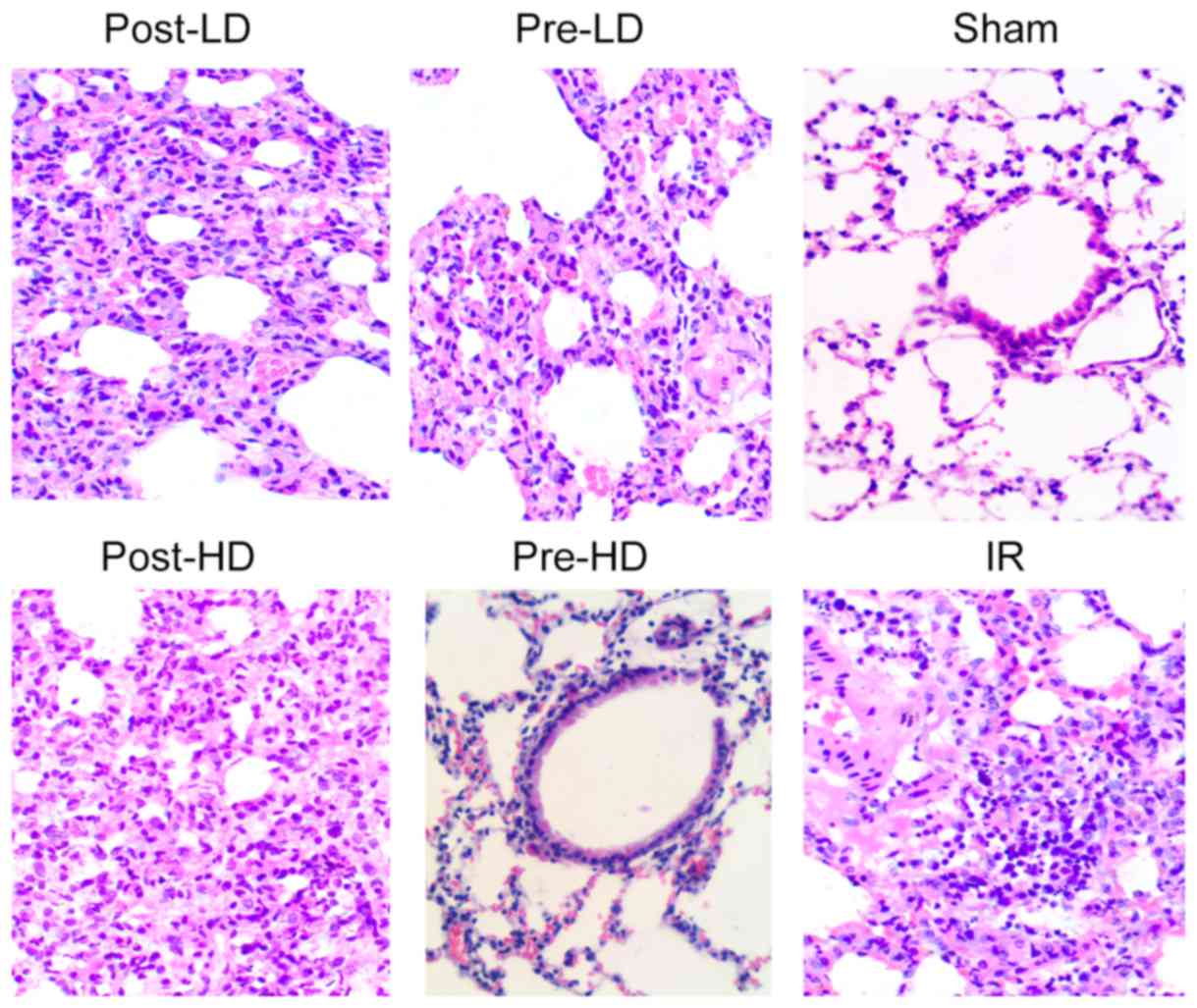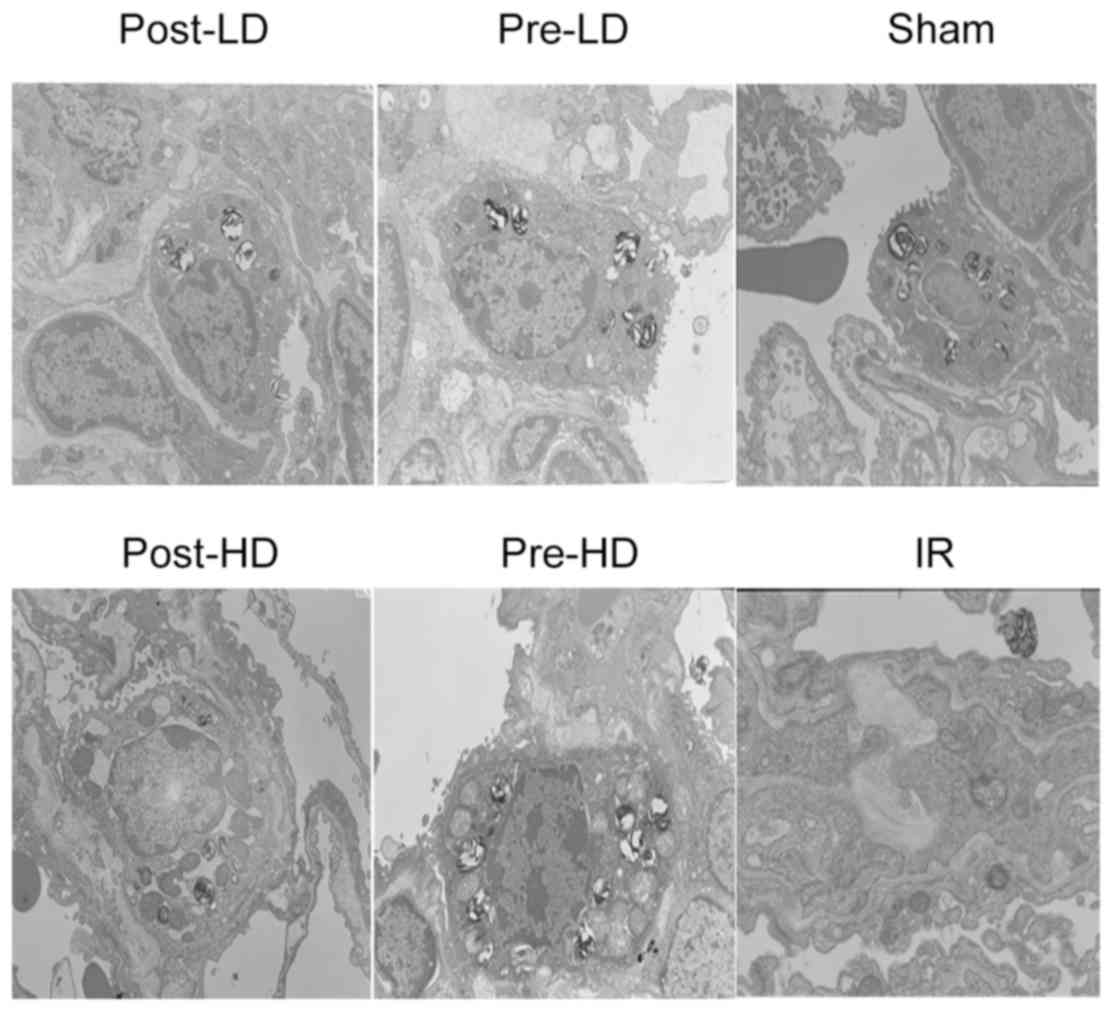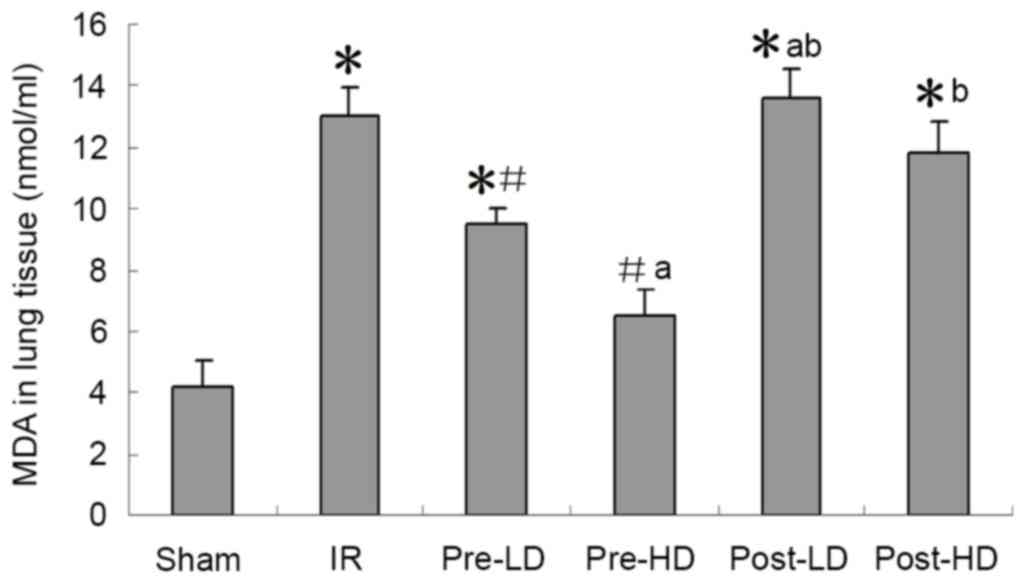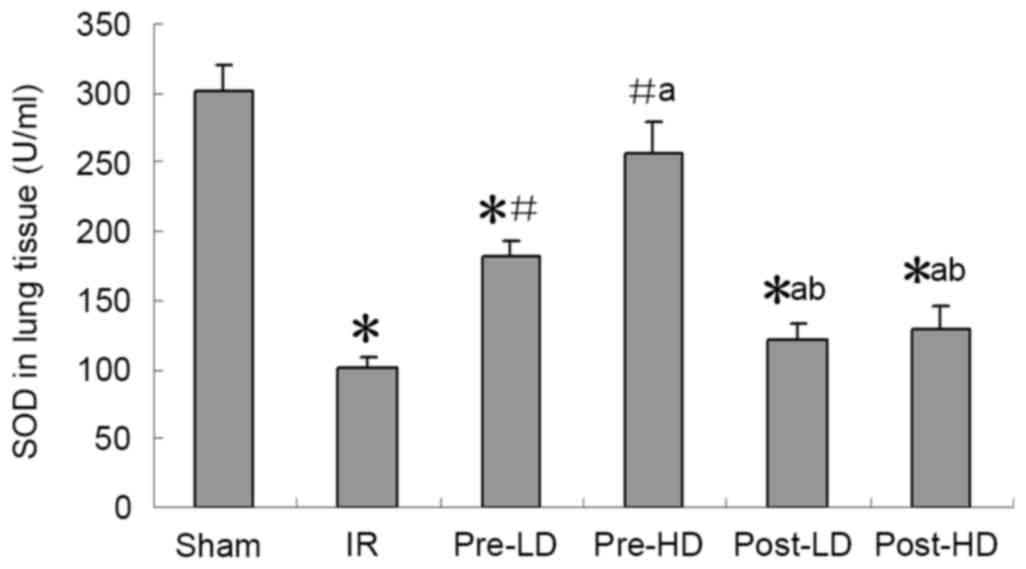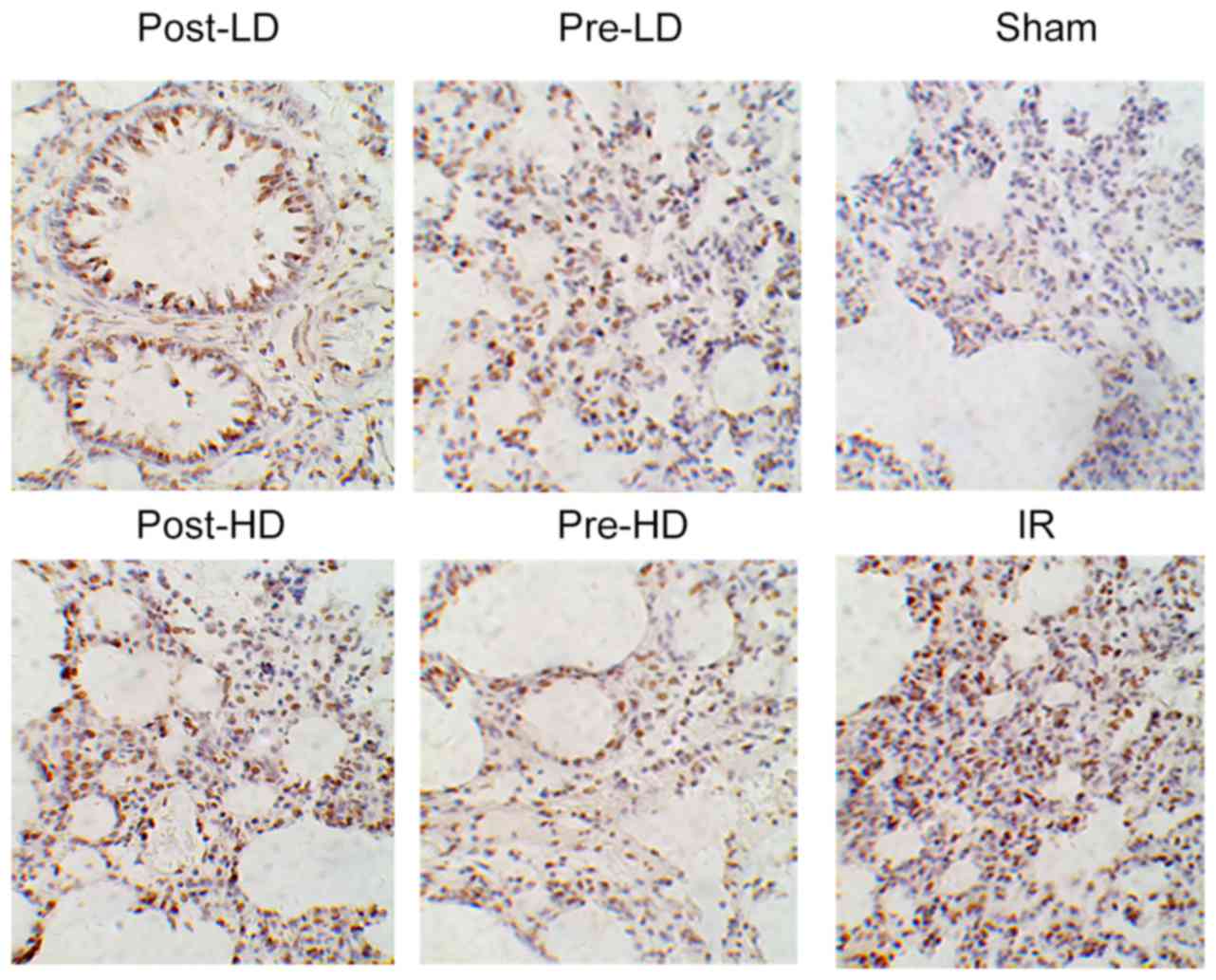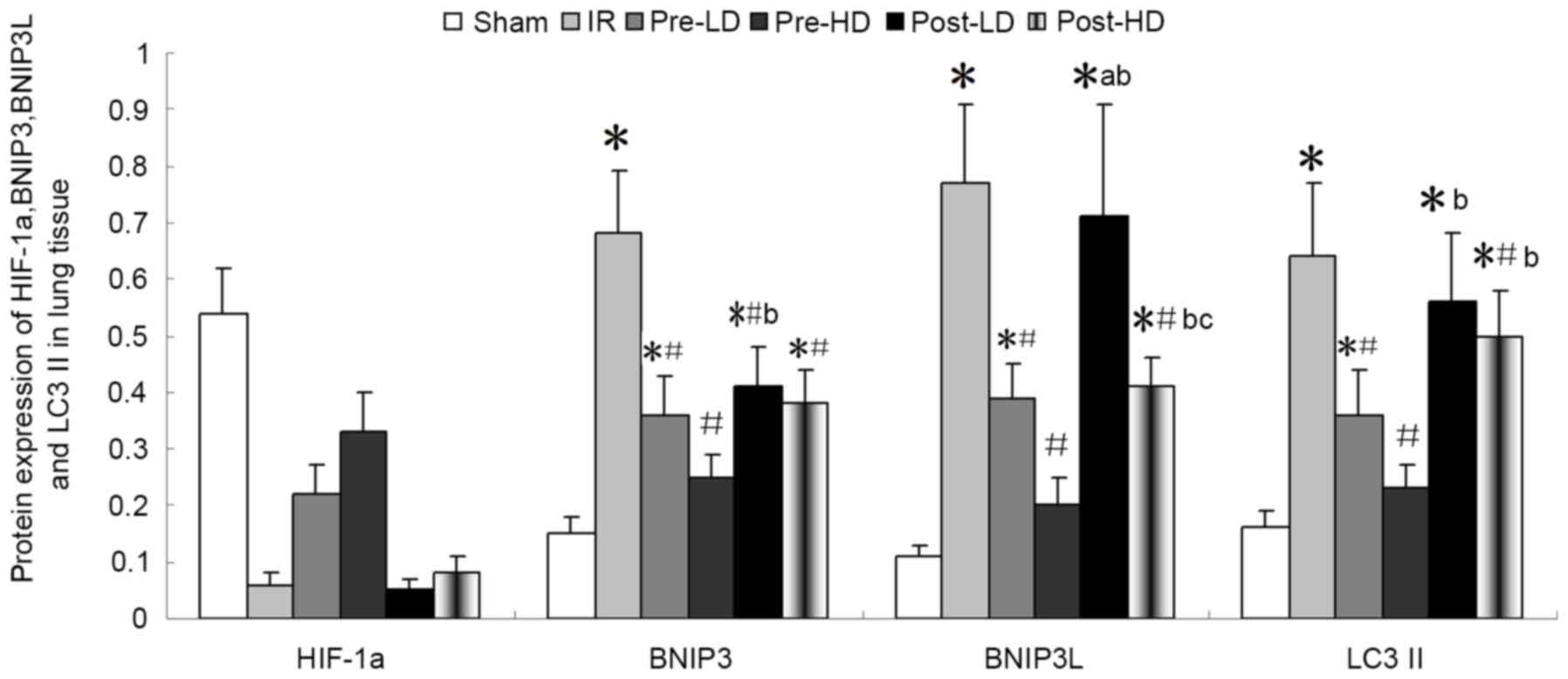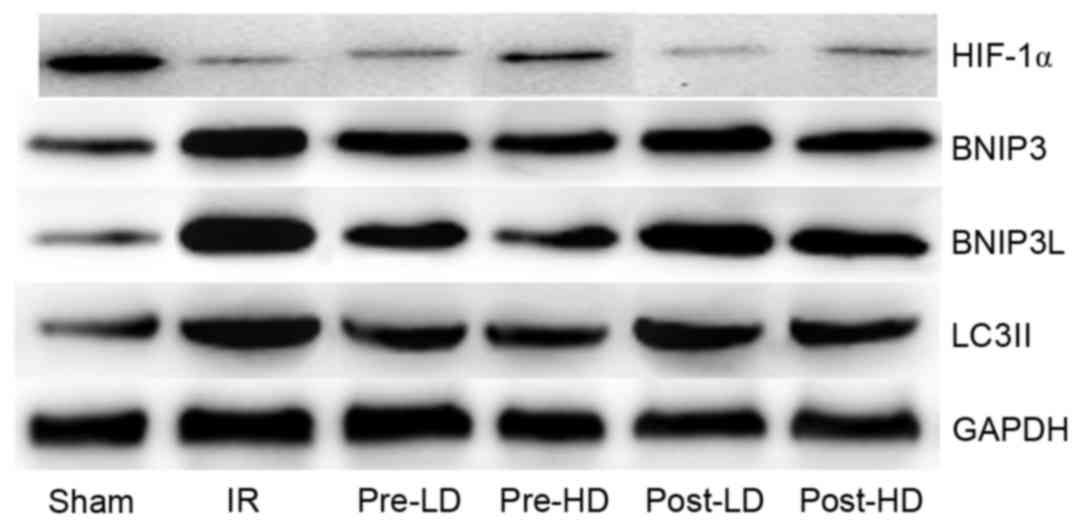Dexmedetomidine preconditioning protects against lung injury induced by ischemia-reperfusion through inhibition of autophagy
- Authors:
- Published online on: June 16, 2017 https://doi.org/10.3892/etm.2017.4623
- Pages: 973-980
-
Copyright: © Zhang et al. This is an open access article distributed under the terms of Creative Commons Attribution License.
Abstract
Introduction
Lung ischemia-reperfusion injury (LIRI), a form of acute sterile lung injury, remains a frequent complication that may result in morbidity and mortality during lung transplantation (1), cardiopulmonary bypass (2), trauma (3), pulmonary embolism (4) and resuscitation in hemorrhagic shock (5). Previous studies have demonstrated that dexmedetomidine may protect against lung injury by promoting the expression of heme oxygenase-1 (6). Pre-administration of dexmedetomidine prior to ischemia-reperfusion (IR) has been identified to reduce pulmonary damage and decrease myeloperoxidase activation in lung tissue, in addition to levels of proinflammatory cytokines in the bronchoalveolar lavage fluid (7). The results of this previous study indicated that dexmedetomidine exerted these effects through the toll-like receptor 4/myeloid differentiation primary response 88/mitogen-activated protein kinase signaling pathway (7).
Autophagy is a cell protective mechanism that is activated in response to stress signals from the endoplasmic reticulum (8). Autophagy occurs from the embryonic period (9) and is fundamental for the growth and differentiation of tissues. Autophagy is involved in the growth and differentiation of alveolar cells (10,11). Depletion of energy and an oxygen deficient environment are triggers for autophagy. It is well known that autophagic cellular damage during ischemia and reperfusion is the basis of ischemia-reperfusion injury (IRI). This is an attempt to survive the severely limiting conditions during ischemia. Previous studies have investigated the role of autophagy in IRI. However, it remains controversial whether high levels of autophagy lessen or aggravate IRI (12,13). Autophagy occurs at low levels basally to mediate homeostatic functions, including organelle and protein turnover. Furthermore, autophagy increases when intracellular nutrition and energy are deficient; for example, in hypoxia or starvation. Autophagy can also trigger apoptosis (14).
A previous study demonstrated that ischemia and immediate reperfusion can trigger autophagy, and that autophagy participates in renal IRI (12). Furthermore, autophagy serves a protective role in LIRI (15). However, in a previous study indicated that autophagy was activated and served a role in the pathophysiological process of LIRI (16). Whether autophagy is associated with the protective effect of dexmedetomidine in LIRI remains unclear. The present study aimed to investigate the underlying molecular mechanism of the protective effect of dexmedetomidine in LIRI.
Materials and methods
Animals
The present study was approved by the Animal Care and Use Committee of Henan Provincial People's Hospital (Zhengzhou, China). Adult (aged 8–10 weeks) male Sprague-Dawley rats (n=48; weight, 250–300 g) were provided by Zhengzhou University Laboratory Animal Center (Zhengzhou, China). The animals were housed in plastic cages with water and food available ad libitum. The temperature (22±1°C) and humidity (60±5%) were controlled in a room with a 12-h light-dark cycle. All the rats were acclimatized to these conditions for 1 week prior to the study.
Establishment of LIRI models
All rats were anesthetized by intraperitoneal injection of 400 mg/kg 10% chloral hydrate (Batch no. 20150121; Tianjin Guangfu Fine Chemical Research Institution, Tianjin, China), and the caudal vein was cannulated for fluid and drug administration. After tracheostomy was completed, all rats were endotracheally intubated with a vein puncture needle and then connected to a breathing machine (Model: HX-100E; Temo Technology Co., Ltd, Beijing, China) specialized for small animals. Rats were placed in a right lateral position and the left lung was exposed through the fifth intercostal space. The hilum of the left lung was occluded with a non-invasive microvascular clip for 30 min. The clip was removed at the end of the ischemic period, and the left lung was allowed to regain ventilation and blood for 2 h. After the experiment was finished, the rats were sacrificed via exsanguination by cardiac puncture and the left lung was removed for further analysis.
Experimental protocol and drug administration
A total of 48 rats were randomly allocated into six groups (n=8 per group) as follows: i) The sham group received saline administration (1 ml/h intravenously) without LIRI; ii) the IR group received saline administration (1 ml/h intravenously) following LIRI; iii) the LIRI + 1 µg/kg dexmedetomidine preconditioning group [pre-low dose (LD)] received 1 µg/kg dexmedetomidine prior to LIRI; iv) the LIRI + 10 µg/kg dexmedetomidine preconditioning group [pre-high dose (HD)] received 10 µg/kg dexmedetomidine prior to LIRI; v) the IR + 1 µg/kg dexmedetomidine postconditioning group (post-LD) received 1 µg/kg dexmedetomidine following LIRI; and vi) the IR +1 0 µg/kg dexmedetomidine postconditioning group (post-HD) received 10 µg/kg dexmedetomidine following LIR.
Drug administration
Dexmedetomidine (Batch no. 15030932; Hengrui Medicine Co., Ltd., Lianyungang, China) preconditioning [0.1 (pre-LD) or 1 (pre-HD) µg/kg/min total over 10 min] was administered intravenously after the caudal vein was opened. Dexmedetomidine postconditioning [0.1 (post-LD) or 1 (post-HD) µg/kg/min total over 10 min) was administered immediately after the reperfusion period started.
Wet/dry (W/D) lung weight ratio
The W/D weight ratio for 3 rats from each group was calculated. The upper lobe of the left lung was immediately weighed following harvest to obtain the wet weight and again following desiccation in a 60°C oven for 48 h to obtain the dry weight. The lung water content was then assessed by the W/D ratio.
Examination of lung injury by light microscopy
The left lungs from 2 rats from each group were perfused with 4% formaldehyde (room temperature for 24 h). The formaldehyde infused left lung samples were embedded in paraffin wax (58°C for 2 h), sectioned (5 µm thick) and stained with hematoxylin and eosin. The samples were subsequently examined using light microscopy at a magnification of ×200 and the mean value of three fields of view was used as to assess the lung injury.
Examination of lung injury by transmission electron microscopy
The left lungs from 2 rats from each group were perfused with 2.5% glutaraldehyde solution (precooled at 4°C) and preserved. Following fixation at 4°C for 24 h with 2.5% glutaraldehyde, the samples were treated with 1/15 M phosphate buffer for 10–15 min, followed by 50, 70, 80, 70 and 100% acetone dehydration washes for 10–15 min each (at room temperature). Tissues were then embedded with EPON 812 resin (at 60°C for 48 h), sectioned into 50-nm-thick ultrathin slices, stained with citric acid and uranyl acetate (room temperature for 30 min) and images captured by transmission electron microscopy (H-7500; Hitachi, Tokyo, Japan). The mean value of three fields of view were used to assess the lung injury.
Superoxide dismutase (SOD) activity and malondialdehyde (MDA) concentration
An ultraviolet spectrophotometer was used to perform a colorimetric determination at a wavelength of 550 nm. Lipid peroxidation was determined by measuring the rate of production of thiobarbituric acid reactive substances (expressed as MDA equivalents) Lung tissues were added to precooled PBS (4°C) and then centrifuged (1,006.2 × g at 4°C for 15 sec) into tissue homogenates by a low-speed homogenate slurry machine (30 sec per time, interval ice bath for 1 min). Following centrifugation by the aforementioned methods, the tissue homogenates were first placed under a 37°C water bath for 40 min and then placed at room temperature for 10 min. The activity of SOD and the concentration of MDA were determined by a 550 nm colorimetric assay according to the manufacturer's protocol (SOD cat no: A001-1 and MDA cat no: A003-1; Nanjing Jiancheng Bioengineering Institute, Nanjing, China).
Detection of lung cell apoptosis by the TUNEL assay
The TUNEL assay was employed according to manufacturer's protocol of the In situ cell death detection kit-POD (cat no. 11684817910; Roche, Basel, Switzerland). Apoptotic cells were indicated by brown-yellow granules in the cytoplasm. The number of apoptotic cells in five random fields of view (magnification, ×400) was calculated. The apoptosis index (AI; %) was expressed as follows: The number of apoptotic cells/ the total number of cells ×100.
Western blotting
The lower lobes of the left lungs of 4 rats from each group were used for western blotting (n=24, 4 from each group). The lung tissues were mixed with RIPA lysis buffer (cat no. P0013; Beyotime Institute of Biotechnology, Shanghai, China) and centrifuged at 10,000 × g at 4°C for 10 min. According to the manufacturer's protocol, protein quantities in the liquid supernatant were detected using the bicinchoninic acid method (Enhanced BCA Protein Assay kit; cat no, P0009; Beyotime Institute of Biotechnology). Then, 12% SDS-PAGE electrophoresis was performed using 80 ug of protein loaded per lane) and proteins were transferred onto a nitrocellulose membrane. The membranes were blocked with 5% skimmed milk in Tris-buffered saline with Tween 20 for 1 h at room temperature, and then incubated overnight at 4°C with rabbit polyclonal antibodies directed against hypoxia-inducible factor 1α (HIF-1α; cat no. sc13515; 1:1,000; Santa Cruz Biotechnology, Inc., Dallas, TX, USA), Bcl-2/adenovirus E1B 19-kDa interacting protein 3 (BNIP3; cat no. sc56167; 1:1,000; Santa Cruz Biotechnology, Inc.), BNIP3-like (BNIP3L; cat no. ab109414; 1:1,000; Abcam, Cambridge, USA) and microtubule-associated protein 1A/1B light chain 3B (LC3II; cat no. sc271625; 1:1,000; Santa Cruz Biotechnology Inc.). After washing, rabbit polyclonal antibodies (secondary antibodies: HRP-labeled rabbit Anti-Goat IgG (H+L), cat no. ZB-2306, 1:5,000; HRP-labeled Goat Anti-Mouse IgG (H+L), cat no. ZB-2305, 1:2,500; ZSGB-BIO, Beijing, China) directed against BNIP3, BNIP3 L, LC3II and HIF-1α were applied to the membranes for 1 h at room temperature, and GAPDH rabbit polyclonal antibody (cat no. sc47724; 1:1,200; Santa Cruz Biotechnology, Inc.) was used as a control. According to the manufacturer's protocol, Protein bands were then visualized using enhanced chemiluminescence detection reagents (BeyoECL Plus; cat no. P0018; Beyotime Institute of Biotechnology), equal volume of liquid A and B were mixed and once coated to the membrane, they were exposed to photographic film. The images were then analyzed and protein expression quantified using Image J2x (version 2.1.4.7) software (National Institutes of Health, Bethesda, MD, USA).
Statistical analysis
All data are presented as the mean ± standard deviation. All statistical tests were performed using SPSS software (version 17.0; SPSS, Inc., Chicago, IL, USA). The statistical differences between groups were assessed by one-way analysis of variance followed by Bonferroni correction. P<0.05 was considered to indicate a statistically significant difference.
Results
Preconditioning with HD dexmedetomidine reduces the W/D ratio following LIRI
The W/D ratios of the IR and post-LD groups were significantly higher compared with the sham group (P<0.05; Fig. 1). The W/D ratio of the post-LD group was also significantly higher compared with that of the pre-HD group (P<0.05; Fig. 1). This indicates that preconditioning with a HD of dexmedetomidine significantly reduces the W/D ratio following LIRI.
Preconditioning with HD dexmedetomidine reduces lung injury following LIRI
Lung injury was evaluated by the standards as follows (light microscopy): Pulmonary interstitial edema, alveolar edema, alveolar congestion and neutrophil infiltration. As illustrated in Fig. 2, histological analysis revealed minimal lung injury in the sham group, while severe lung injury was identified in the IR group and post-LD group. Furthermore, no notable difference in lung injury was revealed between the pre-LD and post-HD groups. By contrast, the lung tissues harvested from the rats in the pre-HD group exhibited notably milder injuries compared with the IR, pre-LD, post-LD and post-HD groups. As presented in Fig. 3, lung injury was assessed through electron microscopy and similar to the results from light microscopy, no significant injury was observed in the sham group, but a significant decrease of alveolar type II epithelium villi and lamellar corpuscles were observed in the IR group. Preconditioning with dexmedetomidine attenuated these injuries.
Preconditioning with HD and LD dexmedetomidine reduces lower MDA and higher SOD following LIRI SOD activity and MDA expression
As presented in Figs. 4 and 5, a significantly higher MDA level and significantly lower SOD activity in the left lung were observed in the IR group compared with the sham group (both <0.05). Compared with the IR group, higher SOD and lower MDA were observed in the pre-LD and pre-HD groups (all P<0.05). However, no significant differences in MDA levels of SOD activity were observed in the post-LD and post-HD groups compared with the IR group.
Preconditioning with HD dexmedetomidine reduces AI following LIRI
As demonstrated in Figs. 6 and 7, compared with the sham group, the AI index of the other five groups were significantly increased (P<0.05). However no significant difference in AI was observed between the IR and post-LD groups. Furthermore, compared with the IR group, the AI index of the pre-LD, pre-HD and post-HD groups was significantly lower (all P<0.05). In addition, no significant difference in AI was observed between the pre-LD and post-HD groups. However, the AI of the pre-HD group was significantly lower compared with the pre-LD group, while the post-LD and post-HD groups exhibited a significant increase in AI when compared with the pre-HD group (P<0.05; Fig. 6).
Preconditioning with HD dexmedetomidine reduces the level of BNIP3, BNIP3L and LC3II
As illustrated in Figs. 8 and 9, expression of BNI3P, BNI3PL and LC3II protein was significantly higher in the IR, pre-LD, post-LD and post-HD groups compared with the sham group (all P<0.05). Compared with the IR group, BNIP3, BNIP3 L and LC3II protein levels were significantly lower in the pre-LD and pre-HD groups (all P<0.05). Notably, the levels of BNIP3, BNIP3 L and LC3II protein were lower in the pre-HD group compared with the pre-LD group, although this difference was not statistically significant. Furthermore, BNIP3, BNIP3 L and LC3II protein levels were significantly lower in the post-HD group compared with the IR group (all P<0.05); however, no significant differences were observed between the pre-LD and post-HD groups.
Preconditioning with HD dexmedetomidine reduces the level of HIF-1α
The level of HIF-1α protein was notably lower in the IR compared with the sham group, although this difference was not statistically significant (Figs. 8 and 9). In addition, compared with the IR group, HIF-1α protein levels were higher in the pre-LD and pre-HD groups. There was not marked differences in HIF-1α levels between the post-LD, post-HD and IR groups.
Discussion
In the present study, lung damage was evaluated by determination of the W/D ratio and imaging techniques. High water content in the lung is a representative symptom of acute lung injury (17), as demonstrated by the severe lung damage observed in the IR group. The results of the present study demonstrated that LD and HD preconditioning with dexmedetomidine attenuated the development of pulmonary edema, as indicated by the significant decrease in the lung W/D ratio compared with the IR group. However, compared with the IR group, a significance decrease in the lung W/D ratio was observed only in the post-HD groups and not the post-LD group. These results indicate that preconditioning with dexmedetomidine can effectively attenuate the development of pulmonary edema; however, only a HD of dexmedetomidine could exert a similar effect when applied in a postconditioning manner. HD dexmedetomidine, applied in a post-conditioning manner had a similar effect to a LD applied in a preconditioning manner. However, HD dexmedetomidine attenuated the development pulmonary edema more effectively when applied in a preconditioning manner compared with a postconditioning manner.
Lung damage observed by light and transmission electron microscopy was consistent with the results of the W/D ratio. The results indicated that preconditioning with dexmedetomidine produces protection against LIRI in a dose-dependent manner. A previous study demonstrated that the injuries induced by intestinal IR in rats improved with the administration of 5 µg/kg/h dexmedetomidine compared with 2.5 µg/kg/h dexmedetomidine prior to ischemia (18). Furthermore, another study demonstrated dexmedetomidine preconditioning, but not postconditioning or treatment with the peripheral α2-adrenergic receptor agonist fadolmidine, ameliorated kidney IRI and inflammatory responses (19). The results of the present study indicate that HD dexmedetomidine postconditioning provides slight protection to the lungs, similar to LD dexmedetomidine applied in a preconditioning manner.
Reperfusion injury is directly associated with the formation of reactive oxygen species (ROS), endothelial cell injury, increased vascular permeability, and the activation and production of neutrophils, platelets, cytokines and the complement system (20). Furthermore, ROS serve a key role in the development of pulmonary injury, which is characterized by an increase in ROS and other free radicals, with an essential role in the sequence of events leading to lung failure (21). The importance of ROS in the pathophysiology of IRI was demonstrated by the injection of free radical scavengers or enzymes, including SOD, catalase and glutathione peroxidase, which was identified to prevent the damage that occurs during reperfusion (22,23). In the present study, SOD activity in the lungs after IRI was significantly higher in the pre-LD and pre-HD groups compared with the IR group, indicating that pre-administration of dexmedetomidine effectively attenuates oxidative stress injuries induced by IR. Oxidative stress and lipid peroxidation serve an important role in distant organ damage following IR. Lipid peroxidation was determined by measuring the rate of production of thiobarbituric acid reactive substances (expressed as MDA equivalents) (24). In the present study, MDA levels were decreased by preconditioning with dexmedetomidine; however, postconditioning with dexmedetomine did not have a protective effect. The results of the present -study suggest that dexmedetomidine alleviates oxidative stress injury induced by IR, but only in a preconditioning manner.
Occlusion of the arterial blood supply is caused by an embolus, resulting in ischemia and consequently a serious imbalance between the supply and metabolic demand for oxygen, causing tissue hypoxia. The HIF-1 transcription factor, which is composed of oxygen-labile HIF-1α and the constitutive HIF-1β subunit, is responsible for the response to hypoxia or ischemia. The activation of HIF-1α serves a protective role in the IRI of several tissues through regulating inflammation (25). HIF-1α contributes to pulmonary vascular dysfunction in LIRI and the HIF-1α stabilizer dimethyloxalylglycine can attenuate IR-induced inhibition of endothelial function (26). In the present study, postconditioning with dexmedetomidine did not upregulate the expression of HIF-1α, while a marked upregulation of HIF-1α was observed in the pre-LD and pre-HD groups.
Autophagy is a highly conserved process that occurs in all eukaryotes. The functional association between autophagy and cellular death or survival is complicated. Autophagy promotes cell survival under conditions of stress and starvation, whereas in other situations autophagic cell death may occur. Previous studies (27–29) have demonstrated that autophagy can be induced by various cellular conditions in IRI, including energy starvation, oxidative stress, endoplasmic reticulum stress and inflammation. Furthermore, the activation of autophagy may be a important process that enhances tissue tolerance to ischemia (30). The renoprotective effects of dexmedetomidine have been identified to be mediated partly by the maintenance of autophagy (21). It appears that autophagy serves a protective role in LIRI and that this protective effect is enhanced with increasing autophagy levels (31). However, it remains controversial whether high levels of autophagy lessen or increase IRI, particularly in lung tissue (16). As demonstrated in the present study, the expression of LC3II, a biomarker of autophagy, was upregulated by IR. Furthermore, preconditioning with dexmedetomidine can reduce autophagy levels; LC3II levels were significantly reduced by preconditioning with dexmedetomidine, particularly with HD dexmedetomidine.
Autophagy and apoptosis determine cellular fate. Autophagy and apoptosis are discrete cellular processes that are mediated by distinct groups of regulatory and executioner molecules (32,33). The underlying mechanisms of the association between autophagy and apoptosis are not yet fully defined; however, recent investigations have revealed that several apoptotic proteins modulate autophagy (34,35). The present study demonstrated that IR-induced apoptosis could be reduced by dexmedetomidine, particularly when administered in a preconditioning manner.
Bcl-2/adenovirus E1B 19-kDa interacting protein 3 (BNIP3) and Bcl-2/adenovirus E1B 19-kDa interacting protein 3 like (BNIP3L), also known as Nix, are members of the BH3-only subfamily of Bcl-2 family proteins, and are critical for the induction of mitochondrial autophagy, in some instances, promotes survival by reducing radical oxygen species (ROS) and DNA damage under hypoxic conditions (36,37). BNIP3 can also induce cell death; however, evidence is not conclusive whether increased BNIP3 expression alone is sufficient for an apoptotic response (37). However, a previous study indicated that (38) autophagic cell death is induced in cancer cell lines with functioning apoptotic mechanisms, hypothesizing that early induction of BNIP3 may be a protective response with prolonged induction leading to cell death.
Recent studies have identified that BNIP3 and BNIP3L, target genes of HIF-1α, are important in autophagy (39–40). BNIP3 serves a role in the induction of hypoxia-induced mitochondrial autophagy (39,41,42). Autophagy can cause cell survival or death, and its role in IRI appears to be model- and/or tissue-dependent (16,21). The present study demonstrated that BNIP3 and BNIP3 L were overexpressed following LIRI, and that preconditioning with dexmedetomidine effectively attenuated IRI by downregulating BNIP3 and BNIP3L. BNIP3 and BNIP3L are known to be target genes of HIF1-α; however, in the present study preconditioning with dexmedetomidine upregulated the expression of HIF1-α. The trend was not consistent with the downregulation of BNIP3 and BNIP3L that was observed following dexmedetomidine preconditioning, thus the exact mechanism underlying this effect remains unclear.
In conclusion, the present study demonstrated that pulmonary IRI was associated with the upregulation of apoptosis and autophagy. Furthermore, preconditioning with dexmedetomidine provided protection against LIRI in a dose-dependent manner, partially through inhibiting autophagy. Dexmedetomidine was observed to upregulate HIF-1α and downregulate BNIP3 and BNIP3 L in the LIRI model in the current study. The results of present study highlight a potential clinical application for dexmedetomidine in reducing LIRI.
Acknowledgements
The present study was supported by the National Natural Science Fund (grant no. U1404807) and Medical Science Research Project of Henan Province (grant no. 201602227).
References
|
Christie JD, Carby M, Bag R, Corris P, Hertz M and Weill D; ISHLT Working Group on Primary Lung Graft Dysfunction, : Report of the ISHLT Working Group on Primary Lung Graft Dysfunction part II: Definition. A consensus statement of the International Society for Heart and Lung Transplantation. J Heart Lung Transplant. 24:1454–1459. 2005. View Article : Google Scholar : PubMed/NCBI | |
|
Ng CS, Wan S, Yim AP and Arifi AA: Pulmonary dysfunction after cardiac surgery. Chest. 121:1269–1277. 2002. View Article : Google Scholar : PubMed/NCBI | |
|
Shimamoto A, Pohlman TH, Shomura S, Tarukawa T, Takao M and Shimpo H: Toll-like receptor 4 mediates lung ischemia-reperfusion injury. Ann Thorac Surg. 82:2017–2023. 2006. View Article : Google Scholar : PubMed/NCBI | |
|
Ambrosio G and Tritto I: Reperfusion injury: Experimental evidence and clinical implications. Am Heart J. 138:S69–S75. 1999. View Article : Google Scholar : PubMed/NCBI | |
|
Reino DC, Pisarenko V, Palange D, Doucet D, Bonitz RP, Lu Q, Colorado I, Sheth SU, Chandler B, Kannan KB, et al: Trauma Hemorrhagic Shock-Induced Lung Injury Involves a Gut-Lymph-Induced TLR4 Pathway in Mice. PLoS One. 6:e148292011. View Article : Google Scholar : PubMed/NCBI | |
|
Jiang L, Li L, Shen J, Qi Z and Guo L: Effect of dexmedetomidine on lung ischemia-reperfusion injury. Mol Med Rep. 9:419–426. 2014.PubMed/NCBI | |
|
Shen J and Fu G, Jiang L, Xu J, Li L and Fu G: Effect of dexmedetomidine pretreatment on lung injury following intestinal ischemia-reperfusion. Exp Ther Med. 6:1359–1364. 2013.PubMed/NCBI | |
|
Ogata M, Hino S, Saito A, Morikawa K, Kondo S, Kanemoto S, Murakami T, Taniguchi M, Tanii I, Yoshinaga K, et al: Autophagy is activated for cell survival after endoplasmic reticulum stress. Mol Cell Biol. 26:9220–9231. 2006. View Article : Google Scholar : PubMed/NCBI | |
|
Tra T, Gong L, Kao LP, Li XL, Grandela C, Devenish RJ, Wolvetang E and Prescott M: Autophagy in human embryonic stem cells. PLoS One. 6:e274852011. View Article : Google Scholar : PubMed/NCBI | |
|
Kuma A, Hatano M, Matsui M, Yamamoto A, Nakaya H, Yoshimori T, Ohsumi Y, Tokuhisa T and Mizushima N: The role of autophagy during the early neonatal starvation period. Nature. 432:1032–1036. 2004. View Article : Google Scholar : PubMed/NCBI | |
|
Komatsu M, Waguri S, Ueno T, Iwata J, Murata S, Tanida I, Ezaki J, Mizushima N, Ohsumi Y, Uchiyama Y, et al: Impairment of starvation-induced and constitutive autophagy in Atg7-deficient mice. J Cell Biol. 169:425–434. 2005. View Article : Google Scholar : PubMed/NCBI | |
|
Suzuki C, Isaka Y, Takabatake Y, Tanaka H, Koike M, Shibata M, Uchiyama Y, Takahara S and Imai E: Participation of autophagy in renal ischemia/reperfusion injury. Biochem Biophys Res Commun. 368:100–106. 2008. View Article : Google Scholar : PubMed/NCBI | |
|
Jiang M, Liu K, Luo J and Dong Z: Autophagy is a renoprotective mechanism during in vitro hypoxia and in vivo ischemia-reperfusion injury. Am J Pathol. 176:1181–1192. 2010. View Article : Google Scholar : PubMed/NCBI | |
|
Gump JM, Staskiewicz L, Morgan MJ, Bamberg A, Riches DW and Thorburn A: Autophagy variation within a cell population determines cell fate through selective degradationof Fap-1. Nat Cell Biol. 16:47–54. 2014. View Article : Google Scholar : PubMed/NCBI | |
|
Zhang D, Li C, Zhou J, Song Y, Fang X, Ou J, Li J and Bai C: Autophagy protects against ischemia/reperfusion-induced lung injury through alleviating blood-air barrier damage. J Heart Lung Transplant. 34:746–755. 2015. View Article : Google Scholar : PubMed/NCBI | |
|
Zhang J, Wang JS, Zheng ZK, Tang J, Fan K, Guo H and Wang JJ: Participation of autophagy in lung ischemia-reperfusion injury in vivo. J Surg Res. 182:e79–e87. 2013. View Article : Google Scholar : PubMed/NCBI | |
|
Luce JM: Acute lung injury and the acute respiratory distress syndrome. Crit Care Med. 26:369–376. 1998. View Article : Google Scholar : PubMed/NCBI | |
|
Zhang XY, Liu ZM, Wen SH, Li YS, Li Y, Yao X, Huang WQ and Liu KX: Dexmedetomidine administration before, but not after, ischemia attenuates intestinal injury induced by intestinal ischemia-reperfusion in rats. Anesthesiology. 116:1035–1046. 2012. View Article : Google Scholar : PubMed/NCBI | |
|
Lempiäinen J, Finchenberg P, Mervaala EE, Storvik M, Kaivola J, Lindstedt K, Levijoki J and Mervaala EM: Dexmedetomidine preconditioning ameliorates kidney ischemia-reperfusion injury. Pharmacol Res Perspect. 2:e000452014. View Article : Google Scholar : PubMed/NCBI | |
|
de Perrot M, Liu M, Waddell TK and Keshavjee S: Ischemia-reperfusion-induced lung injury. Am J Respir Crit Care Med. 167:490–511. 2003. View Article : Google Scholar : PubMed/NCBI | |
|
Zimmerman BJ and Granger DN: Mechanisms of reperfusion injury. Am J Med Sci. 307:284–292. 1994. View Article : Google Scholar : PubMed/NCBI | |
|
De Greef KE, Ysebaert DK, Ghielli M, Vercauteren S, Nouwen EJ, Eyskens EJ and De Broe ME: Neutrophilsand acute ischemia-reperfusion injury. J Nephrol. 11:110–122. 1998.PubMed/NCBI | |
|
Oredsson S, Plate G and Qvarfordt P: Experimental evaluation of oxygen free radical scavengers in the prevention of reperfusion injury in skeletal muscle. Eur J Surg. 160:97–103. 1994.PubMed/NCBI | |
|
Deby C and Goutier R: New perspectives on the biochemistry of superoxide anion and the efficiency of superoxide dismutases. Biochem Pharmacol. 39:399–405. 1990. View Article : Google Scholar : PubMed/NCBI | |
|
Feinman R, Deitch EA, Watkins AC, Abungu B, Colorado I, Kannan KB, Sheth SU, Caputo FJ, Lu Q, Ramanathan M, et al: HIF-1 mediates pathogenic inflammatory responses to intestinal ischemia-reperfusion injury. Am J Physiol Gastrointest Liver Physiol. 299:G833–G843. 2010. View Article : Google Scholar : PubMed/NCBI | |
|
Zhao X, Jin Y, Li H, Wang Z, Zhang W and Feng C: Hypoxia-inducible factor 1 alpha contributes to pulmonary vascular dysfunction in lung ischemia-reperfusion injury. Int J Clin Exp Pathol. 7:3081–3088. 2014.PubMed/NCBI | |
|
Scherz-Shouval R, Shvets E, Fass E, Shorer H, Gil L and Elazar Z: Reactive oxygen species are essential for autophagy and specifically regulate the activity of Atg4. EMBOJ. 26:1749–1760. 2007. View Article : Google Scholar | |
|
Høyer-Hansen M, Bastholm L, Szyniarowski P, Campanella M, Szabadkai G, Farkas T, Bianchi K, Fehrenbacher N, Elling F, Rizzuto R, et al: Control of macroautophagy by calcium, calmodulin-dependent kinase kinase-beta, and Bcl-2. Mol Cell. 25:193–205. 2007. View Article : Google Scholar : PubMed/NCBI | |
|
Zhang J, Wang JS, Zheng ZK, Tang J, Fan K, Guo H and Wang JJ: Participation of autophagy in lung ischemia-reperfusion injury in vivo. J Surg Res. 182:e79–e87. 2013. View Article : Google Scholar : PubMed/NCBI | |
|
Matsui Y, Kyoi S, Takagi H, Hsu CP, Hariharan N, Ago T, Vatner SF and Sadoshima J: Molecular mechanisms and physiological significance of autophagy during myocardial ischemia and reperfusion. Autophagy. 4:409–415. 2008. View Article : Google Scholar : PubMed/NCBI | |
|
Zhang D, Li C, Zhou J, Song Y, Fang X, Ou J, Li J and Bai C: Autophagy protects against ischemia/reperfusion-induced lung injury through alleviating blood-air barrier damage. J Heart Lung Transplant. 34:746–755. 2015. View Article : Google Scholar : PubMed/NCBI | |
|
Maiuri MC, Zalckvar E, Kimchi A and Kroemer G: Selfeating and self-killing: Crosstalk between autophagy and apoptosis. Nat Rev Mol Cell Biol. 8:741–752. 2007. View Article : Google Scholar : PubMed/NCBI | |
|
Eisenberg-Lerner A, Bialik S, Simon HU and Kimchi A: Life and death partners: Apoptosis, autophagy and the cross-talk between them. Cell Death Differ. 16:966–975. 2009. View Article : Google Scholar : PubMed/NCBI | |
|
Feng Z, Zhang H, Levine AJ and Jin S: The coordinate regulation of the p53 and mTOR pathways in cells. Proc Natl Acad Sci USA. 102:pp. 8204–8209. 2005; View Article : Google Scholar : PubMed/NCBI | |
|
Kim SY, Song X, Zhang L, Bartlett DL and Lee YJ: Role of Bcl-xL/Beclin-1 in interplay between apoptosis and autophagy in oxaliplatin and bortezomib-induced cell death. Biochem Pharmacol. 88:178–188. 2014. View Article : Google Scholar : PubMed/NCBI | |
|
Hamacher-Brady A, Brady NR, Logue SE, Sayen MR, Jinno M, Kirshenbaum LA, Gottlieb RA and Gustafsson AB: Response to myocardial ischemia/reperfusion injury involves Bnip3 and autophagy. Cell Death Differ. 14:146–157. 2007. View Article : Google Scholar : PubMed/NCBI | |
|
Tracy K, Dibling BC, Spike BT, Knabb JR, Schumacker P and Macleod KF: BNIP3 is an RB/E2F target gene required for hypoxia-induced autophagy. Mol Cell Biol. 27:6229–6242. 2007. View Article : Google Scholar : PubMed/NCBI | |
|
Azad MB, Chen Y, Henson ES, Cizeau J, McMillan-Ward E, Israels SJ and Gibson SB: Hypoxia induces autophagic cell death in apoptosis-competent cells through a mechanism involving BNIP3. Autophagy. 4:195–204. 2008. View Article : Google Scholar : PubMed/NCBI | |
|
Zhang H, Bosch-Marcc M, Shimoda LA, Tan YS, Baek JH, Wesley JB, Gonzalez FJ and Semenza GL: Mitochondrial autophagy is an HIF-1-dependent adaptive metabolic response to hypoxia. J Biol Chem. 283:10892–10903. 2008. View Article : Google Scholar : PubMed/NCBI | |
|
Novak I, Kirkin V, McEwan DG, Zhang J, Wild P, Rozenknop A, Rogov V, Löhr F, Popovic D, Occhipinti A, et al: Nix is selective autophagy receptor for mitochondrial clearance. EMBO Rep. 11:45–51. 2010. View Article : Google Scholar : PubMed/NCBI | |
|
Band M, Joel A, Hernandez A and Avivi A: Hypoxia-induced BNIP3 expression and mitophagy: In vivo comparision of the rat and the hypoxia-tolerant mole, Spalax ehrenbergi. FASEB J. 23:2327–2335. 2009. View Article : Google Scholar : PubMed/NCBI | |
|
Bellot G, Garcia-Medina R, Gounon P, Chiche J, Roux D, Pouysségur J and Mazure NM: Hypoxia-induced autophagy is mediated through hypoxia-inducible factor induction of BNIP3 and BNIP3L via their BH3 domains. Mol Cell Biol. 29:2570–2581. 2009. View Article : Google Scholar : PubMed/NCBI |



